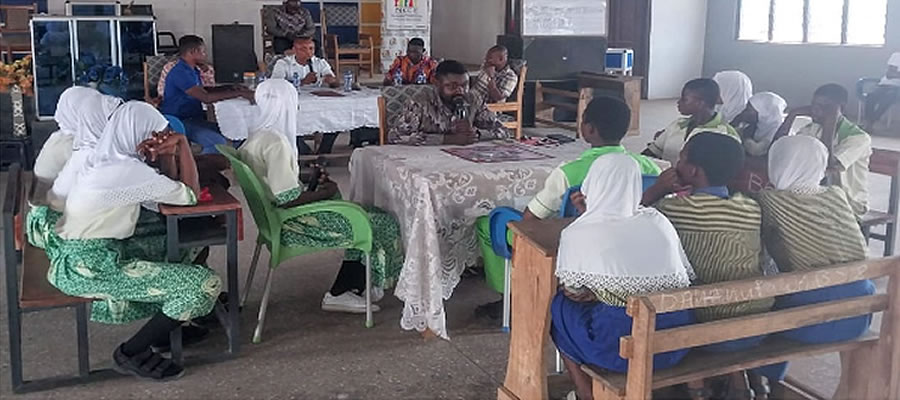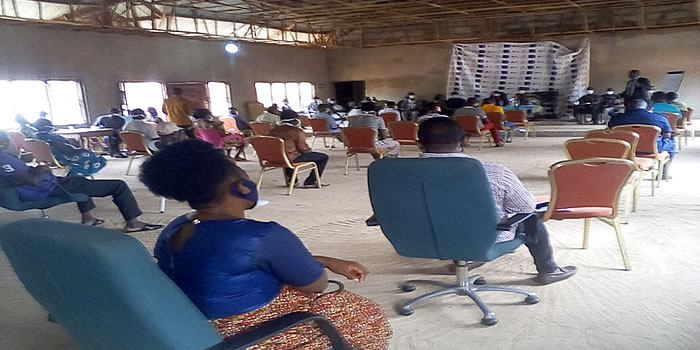

Harmonization of key development issues under GSGDA II with implication for 2018- 2021 with Agenda for Jobs, 2018-2021
In order to prepare a district plan in the context of the national development framework, harmonized issues with implication for 2018-2021 were harmonized with the issues from the Agenda for Jobs, 2018-2021. This was to help the district move in the same development direction with the nation as a whole. Table 2.3 shows the results for the harmonization.
Table 2.3: Harmonisation of key development issues under GSGDA II with the Agenda for Jobs, 2018–2021
Table 2.3 above shows harmonious relationship between issues from Agenda for Jobs 2018-2021 and issues under GSGDA II. Therefore the issues under Agenda for Jobs, 2018-2021 were adopted for policy interventions. These adopted issues were group under the various development dimensions of Agenda for Jobs, 2018-2021 as shown in table 2.4 below;
Table 2.4 Adopted Development Dimensions and Issues of SMTDP of the District
Prioritization of Development Issues The issues adopted from Agenda for Jobs, 2018-2021 were prioritized by DPCU to know which of them needs urgent attention, considering available limited resources. Some tools like POCC analysis was used during the process of prioritization. The result is shown below.
POCC Analysis
The harmonized issues under the various thematic areas were further subjected to POCC analysis. This is imperative in order to determine the potentials and opportunities which can help in solving the problems identified and how to use these potentials and opportunities to neutralize the constraints and challenges. The output from the POCC analysis will help in the prioritization of issues. The outputs are presented below
Table 2.5 POCC analysis
All the issues were assessed through POOC analysis as shown above.
Impact Analysis
The development issues were assessed through POCC analysis to know their strengths and weaknesses in implementation. The strength of the issues were also tested against the following criteria;
· Significant linkage effect on meeting basic human needs/rights – e.g. immunisation of children and quality basic schooling linked to productive citizens in future, reduction of gender discrimination linked to sustainable development;
· Significant multiplier effect on economic efficiency, e.g. attraction of investors, job creation, increases in incomes and growth.
· Impact on:
a) The different population groups (e.g. girls, aged, disabled);
b) Balanced development;
c) Natural resource utilisation;
d) Cultural acceptability;
e) Resilience and disaster risk reduction;
f) Climate change mitigation and adaptation;
· Opportunities for the promotion of cross-cutting issues
Impact Analysis
Prioritized Development Issues with positive significant impacts under Agenda for Jobs (2018-2021)
Sustainability Analysis of the Prioritised Issues
Prioritised development issues with positive significant impact in table ……. The issues were subjected to further strategic environmental analysis to access their internal consistency and compatibility. The results indicate that there shall sustainability of the objectives including supporting the natural environment, social and cultural conditions, the economy and institutional development. We identified negligible negative and insignificant impacts and could not affect objectives.
There was also a very strong linkage between identified issues. The collective support between issues will lead to achievement of the objectives of MTDP. There was internal consistency and compatibility between identified issues.
Sustainable Environmental Analysis of prioritised Development Issues of NMTDPF 2018- 2021
List of prioritized adopted Issues
Having done all these analysis, DPCU presented the following List as the prioritized adopted issues of the district;
1. Poor quality and inadequate road transport network
2. Youth unemployment and underemployment among rural and urban youth
3. Poor quality of education at all levels
4. Gaps in physical access to quality health care
5. Low application of technology especially among smallholder farmers leading to comparatively lower yields
6. Inadequate potable water supply
7. Inadequate access to affordable credit
8. Ineffective monitoring and evaluation of implementation of development policies and plans
9. Poor sanitation and waste management
10. Poor quality of healthcare services
11. Difficulty in the extension of grid electricity to remote rural and isolated communities
12. Limited coverage of social protection programmes targeting children
13. Growing incidence of child marriage, teenage pregnancy and accompanying school dropout rates
14. Weak capacity of caregivers
15. High incidence of children?s rights violation
16. Inadequate and limited coverage of social protection programmes for vulnerable groups
17. High incidence of HIV and AIDS among young persons
18. Revenue underperformance due to leakages and loopholes, among others
19. Narrow tax base
20. Poor marketing systems
21. Erratic rainfall patterns
22. Lack of entrepreneurial skills for self-employment
23. Illegal farming and harvesting of plantation timber Forest fires
24. Inadequate and obsolete electricity grid network
25. Inadequate agribusiness enterprise along the value chain
26. Scattered and unplanned human settlements
27. Gender disparities in access to economic opportunities
28. Poor drainage system
29. Weak implementation of administrative decentralization
30. Poor tourism infrastructure and Service
31. Poor storage and transportation systems
32. Low productivity and poor handling of livestock/ poultry products
33. Unmet needs for mental health services
34. Low broadband wireless access
35. Weak involvement and participation of citizenry in planning and budgeting
36. Inadequate and poor quality equipment and infrastructure
37. Weak extension services delivery
38. Poor living conditions of PWDs
39. Unfavourable socio-cultural environment for gender equality
40. Ineffective sub-district structures
Date Created : 7/14/2023 12:00:00 AM










 facebook
facebook
 twitter
twitter
 Youtube
Youtube
 +233 593 831 280
+233 593 831 280 0800 430 430
0800 430 430 GPS: GE-231-4383
GPS: GE-231-4383 info@ghanadistricts.com
info@ghanadistricts.com Box GP1044, Accra, Ghana
Box GP1044, Accra, Ghana